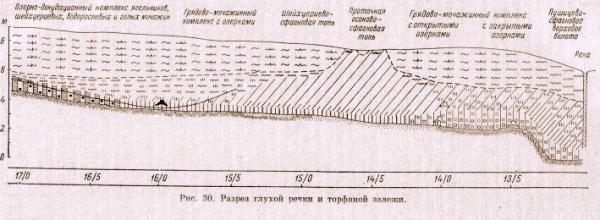Two stages can be distinguished in the history of scientific research before the creation of the reserve.
The first of them was started in the pre-revolutionary time, continued in the Soviet years and was connected with the study of the structure of the peat deposit and determination of peat reserves. The need for geological and geomorphological research at that time was caused by the need of the national economy in the development and exploitation of new mineral deposits, as well as with the study of the possibility of draining the bog to create land suitable for agriculture. In the late 1920s and early 1930s, geological and geomorphological studies were carried out on the territory of the Polistovo-Lovatskaya bog system at the expense of the Leningrad branch of the Peat Research Institute.
The first studies of the eastern Pskov bog area were carried out in 1909-1914, with V. N. Sukachev at the head of the work. The works were carried out by his students, first of all by R.I. Abolin, who compiled an epigenological classification of the bogs (Abolin, 1914). The work of Kaks (1914), which emphasizes the importance of the water factor for high bogs, is noteworthy.
The Soviet period of studying the Polistovo-Lovatskaya bog system began in 1928. A rainy summer resulted in a crop failure in the Pskov region. The population of the villages located in the bog massif had to add ground sphagnum to flour, which caused stomach diseases.
Large works were organized to level the bogs on the right bank of the Polist River and to straighten and deepen its riverbed. Z.N. Smirnova led studies of the bogs on the left bank of the Polist River, and I.D. Bogdanovskaya-Gienef led studies on the right bank. The materials of Z.N. Smirnova were lost during the Great Patriotic War, and the work remained unfinished. Bogdanovskaya-Gienief's studies were published in the form of a monograph entitled "The regularities of the formation of sphagnum raised bogs on the example of the Polistovo-Lovatskaya bog massif" (Bogdanovskaya-Gienief, 1969). The work characterizes the vegetation and structure of the peat deposit of the bog massif and shows that the present-day distribution of vegetation groups and their change in the past, and, consequently, the structure of the peat deposit are determined primarily by hydrological factors.
The first botanical and geobotanical studies were carried out in parallel with geological ones. Based on the observations in the Polistovo-Lovat massif, R.I. Abolin gave a description of bog pine forms (Abolin, 1915). A detailed description of the vegetation is given in the work of I.D. Bogdanovskaya-Gienef.
The second stage was directly related to the design and creation of the State Nature Reserve, defining the boundaries of the specially protected natural territory. In the early 90's the work on the design of the State Nature Reserve began, which was coordinated by the State Committee for Ecology of the Pskov region (now the Department of the Federal Service for Supervision of Natural Resources in the Pskov region).
The organization which carried out the works was the Design and Research Expedition of the Central Research Laboratory of the Department for Conservation and Rational Use of Hunting Resources on the basis of the agreement with the Federal Environmental Fund (No.12 of 14.05.1993). The scientific supervisor of the works was V.V. Dezhkin, and the head of the design and survey party was leading specialist V. M. Zlobin. The party consisted of specialists from different areas of science: V.G. Smorkalov, zoologist, A.L. Mishchenko, botanist O.M. Sukhanova, cartographer V.V. Zhuravleva. They described and mapped the borders of the Reserve, gave the main physical and geographical characteristics of the protected natural area, made the first lists of flora and fauna of the Reserve.




